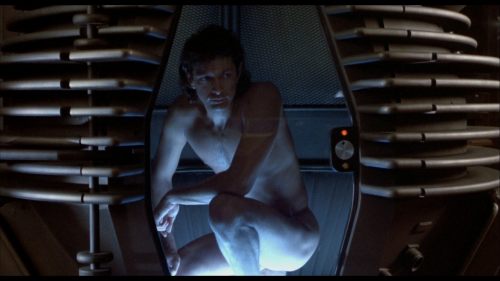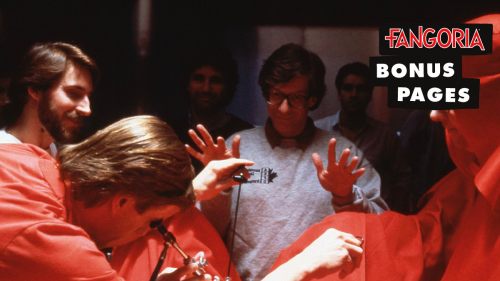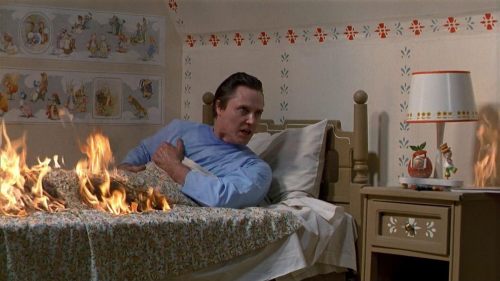Everybody’s Into Weirdness: Rabid (1977)
The Alamo Drafthouse is a brand built on weird. Beyond being situated in a town that has long aspired to remain eccentric in the face of all normality, it’s easy to forget that the original Alamo started as something of a private screening club, running prints of the odd and obscure into all hours of the night. Though the company has obviously grown into an internationally recognized chain of first run movie palaces, the Drafthouse Ritz in Austin, Texas remains committed to showcasing genre repertory programming, namely via its Terror Tuesday and Weird Wednesday showcases. This column is a concentrated effort to keep that spirit of strangeness alive, as programmers Joe A. Ziemba and Laird Jimenez (often pulling from the extensive AGFA archives) are truly doing Satan’s bidding by bringing ATX weekly doses of delightful trash art.
The thirtieth entry into this disreputable canon is David Cronenberg’s vampiric body horror picture, Rabid…
Year: 1977
Trailers: They Came From Within; Scanners
Rabid isn’t David Cronenberg’s best film. Truthfully, it doesn’t even place in the Top Five. Nevertheless, Rabid still feels like an important stepping-stone in the auteur’s growth and maturity as a filmmaker. Slightly more polished than They Came From Within (a/k/a Shivers), yet still retaining the ruddy sheen of Canadian government funded filmmaking, his body horror vampire tale of primal sex run rampant transports terror from the confines of a monolithic high rise and lets it spill into the streets of Montreal, perverting everyone in sight. The seeds of later Cronenberg pictures are being sown in individual scenes, all while he provides a midnight creature feature companion to George A. Romero’s The Crazies. Destruction comes in the shape of adult film star Marilyn Chambers, whose living host is the nightmare manifestation of a man’s sex negative view of his fairer half.
Ostensibly a thematic continuation of They Came From Within (which, despite causing much controversy in its home country, grossed a modest $5 million worldwide), infection is still on Cronenberg’s mind. Only here it isn’t a parasitic creation that causes the epidemic, but rather a franchising of cosmetic surgery. After young, beautiful Rose (Chambers, in her first non-pornographic role) is horribly injured in a motorcycle accident, she is reconstructed at the Keloid Clinic by the newly anointed “Colonel Sanders of Plastic Surgery” (Howard Ryshpan). However, the man’s attempt to alter (and, in essence, neutralize) her biology results in a ripple in Seth Brundle’s beloved “plasma pool”, as Rose develops a stinger beneath her armpit, through which she feeds on the blood of others and spreads a new, indiscriminate infestation. She’s a human “mosquito” (which, unsurprisingly, was the original title of Cronenberg’s treatment), delivering disease as she struggles to come to terms with her grisly existence.
The not so secret weapon of Rabid is Chambers. Following her performance in Terrence Malick’s Badlands, Cronenberg wanted to cast Sissy Spacek in the Rose role. But producer Ivan Reitman knew that Chambers was attempting to cross over into “legitimate” acting (though labeling pornography “illegitimate” seems disingenuous, given the massive mainstream success of Behind the Green Door). Cronenberg initially balked at the idea, but gave in to his producers’ wishes upon realizing Chambers’ star power actually trumped Spacek’s at the international box office*. What results is an odd, deadpan performance, with Chambers utilizing her body like a weapon. Watching her writhe with a farm animal as she drinks its blood before casually seducing another victim inside of a porn theater (as the line “thanks to you, I’m a freak!” echoes through the auditorium) is chilling; Chambers’ level of detachment meets her director’s clinical approach to the material.
Unfortunately, Chambers’ casting also emphasizes the movie’s somewhat troubling sex negativity – an attitude wholly uncharacteristic for Cronenberg. In the filmmaker’s later pictures, sex acts as a catalyst for transformation, both emotional and physical (his car wreck fetish feature, Crash, being the most obvious example). It’s a true act of discovery and creation. In Rabid, sex is merely a method to achieve annihilation, holding grim finality for an entire species. Were one not familiar with the director’s other work, this wholly harmful attitude would seem almost prudish, especially give the extra-textual details of Chambers’ pornographic background. Cronenberg has never been an artist focused on damnation, yet Rabid flies in the face of his usual openness, to the point of becoming paradoxical.
Though he was working with a considerably higher budget than was allotted by the CFDC on They Came From Within ($565,000, as opposed to $185,000), Cronenberg’s greatest challenge was depicting how Rose’s plague invades downtown Montreal. Still, the director manages to create a sense of overwhelming chaos, ramping up the violence as attacks break out in subway tubes and machine guns light up shopping malls. Adding a layer of domestic insecurity is the director’s insistence on setting his world-ending tale at Christmastime. One of the more striking images contained within Rabid is Santa Claus becoming collateral damage, all while government officials up the levels of violence to dispose of the crazies overrunning their streets. The movie is grim and often gut wrenching, but that doesn’t stop Cronenberg from injecting his usual sense of dry gallows humor. He’s poking and prodding your funny bone as you squirm uncomfortably in your seat.
There are moments within Rabid that feel like brief sketches Cronenberg would later expand into features of their own, as well as ideological motifs that would come to dominate the rest of his filmography. When Rose, now fully aware of her complete transformation, confronts her ex-lover (Frank Moore) in a fit of desperation, it feels like pupa that would eventually blossom into The Fly. Scientific hubris leading to brand-specific division would be fully explored in Videodrome (via warring TV cultists), and in a very literal biological sense in Dead Ringers (complete with specialty gynecological instruments for “mutant women”). So while Rabid is certainly flawed, those devoted to dissecting the mad Canadian’s ever-fascinating body will find much to contextually mine.
Despite being something of a filmic jumble, Rabid delivers the midnight movie goods, so much so that it solidified Cronenberg’s reputation (at least within the '70s Canadian media) as being a filmmaker aligned with American genre kingpins like Roger Corman. But Cronenberg didn’t want to be classified; he had the mind of an intellectual – reared on both science and literature – and wanted to flex that prowess within constructs yet to be fully fleshed out. As soon as he became comparable to a particular sensibility (genre or otherwise), it allowed both critics and audiences to place him inside of a box and dismiss whatever subversive intent he was harboring without giving it the proper consideration. “I’ll be the first Cronenberg,” the filmmaker said to an interviewer in 1976, “they can, and in England they do, talk about a ‘Cronenbergesque’ film.” That’s the beauty of the shock auteur – his ability to retain a unique identity while still delivering something identifiable within a greater body. His vision is one that acknowledges the individual’s possession of both the ability to create and destroy one’s own self. We are all both Genesis and Apocalypse made flesh and walking amongst other unknowing time bombs.
*Though, in a funny turn of events, her rejection would lead to the starring role in Brian De Palma’s Carrie (whose poster is featured in Rabid), which became the defining role of her career.
This Week at Weird Wednesday: Star Crash
Previous WW Features: Penitentiary; Skatetown USA; Blood Games; The Last Match; Invasion of the Bee Girls; Julie Darling; Shanty Tramp; Coffy; Lady Terminator; Day of the Dead; The Kentucky Fried Movie; Gone With the Pope; Fright Night; Aliens; Future-Kill; Ladies and Gentlemen…The Fabulous Stains; Pieces; Last House on the Left; Pink Flamingos; In the Mouth of Madness; Evilspeak; Deadly Friend; Don’t Look in the Basement; Vampyres; She; Dolls; Alice, Sweet Alice; Starship Troopers; Message From Space



